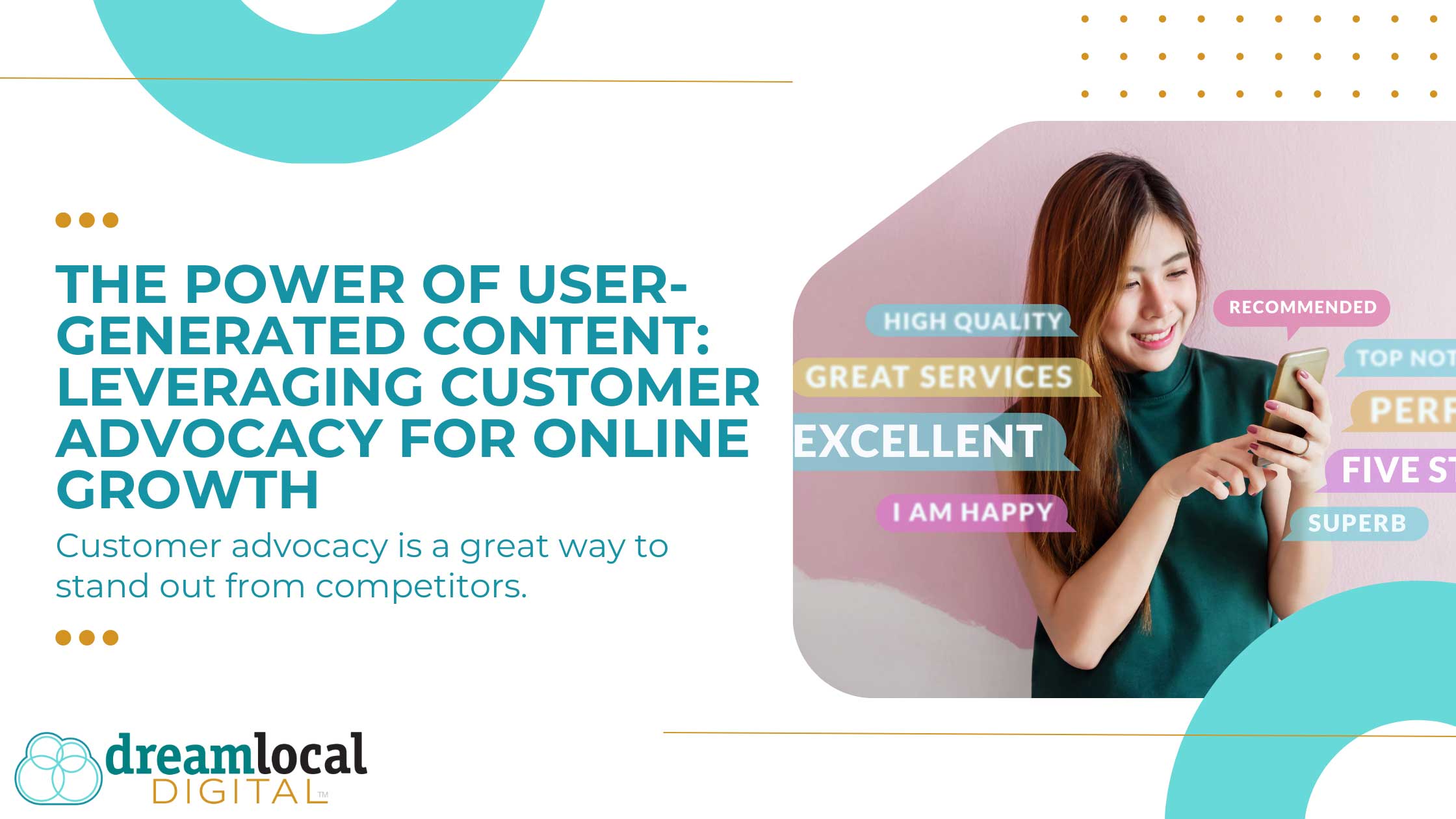The Power of User-Generated Content: Leveraging Customer Advocacy for Online Growth

In today’s fast-paced digital world, businesses face an uphill battle in earning and maintaining consumer trust and loyalty. Trying to stand out in a crowd of competitors feels like a needle in a haystack. And with social media magnifying every positive review and critique, the pressure to cultivate authentic brand advocates has never been greater.
Customer advocacy emerges as a solution to manage these challenges and foster long-term growth. Let’s explore why customer advocacy is important and how you can use it.
What Is Customer Advocacy?
Customer advocacy is when customers become your biggest fans, actively promoting and recommending your brand to others. These enthusiasts go beyond mere satisfaction, passionately sharing their positive experiences through word-of-mouth, social media and online reviews.
Their recommendations hold immense influence, boosting your brand’s reputation, credibility and customer base. Customer advocates are invaluable assets for any business, acting as voluntary brand ambassadors and driving growth through their genuine enthusiasm.
Types of Customer Advocacy
Customer advocacy takes many forms, one of the most effective being user-generated content like comments, forums and videos. Here are other common forms of customer advocacy:
-
Customer Reviews and Ratings: Customers leave reviews and ratings on platforms like Google, Yelp, Amazon and TripAdvisor, providing feedback that influences other potential customers’ purchasing decisions.
-
Referral Programs: Businesses can incentivize existing customers, in effect making them advocates, to refer new customers by offering rewards, discounts or other benefits for successful referrals.
-
Customer Feedback and Surveys: This includes direct customer feedback on surveys, feedback forms or social media polls to understand their needs, preferences and satisfaction levels.
-
Customer Communities and Forums: Online communities or forums where customers can connect with each other, share experiences, ask questions, and provide support related to a brand or product.
Benefits of Customer Advocacy
Customer advocacy provides many short-term and long-term benefits. Let’s see what customer advocacy can do for your brand:
-
Building Trust and Loyalty: When customers feel heard and valued, they are more likely to develop trust and loyalty toward a brand. Businesses can strengthen their relationships with their customer base by actively advocating for customers’ needs and concerns. Customers are 2.4 times more inclined to think of user-generated content as genuine than brand content.
-
Enhancing Reputation: Positive word-of-mouth and reviews are powerful in the digital era. Customers with positive experiences are likelier to share them online, significantly enhancing a company’s reputation and attracting new customers.
-
Differentiation in a Competitive Market: Customer advocacy can be a key differentiator for businesses in a crowded marketplace. Companies prioritizing customer advocacy stand out by demonstrating their commitment to customer satisfaction and building stronger connections with their audience.
-
Reducing Churn and Increasing Retention: Businesses can reduce churn rates and increase customer retention by addressing customer concerns and providing excellent service. Satisfied customers are more likely to continue using a company’s products or services and become repeat customers over time.
-
Driving Growth and Revenue: Happy customers are more likely to make repeat purchases and recommend a brand to others, leading to increased revenue and sustainable growth. Customer advocacy can thus have a direct impact on a company’s bottom line.
How To Identify Advocates
To identify your advocates, monitor sources where customers express their opinions and experiences. Here’s how you can do it:
-
Social Media Monitoring: Keep an eye on social media platforms where customers might mention your brand. Look for posts, comments and mentions that praise or recommend your products or services.
-
Review and Survey Sites: Regularly check review websites like Yelp, TripAdvisor or industry-specific platforms where customers leave feedback. Pay attention to positive reviews and recommendations from satisfied customers.
-
Loyalty Programs: Analyze data from your loyalty programs to identify customers who frequently engage with your brand, make repeat purchases or refer others. These loyal customers are likely to become advocates.
Building Relationships and Encouraging Advocacy
Once you identify customers who love your product and are willing to share, begin nurturing the relationship. Here’s how:
-
Provide Excellent Customer Service: Offer top-notch customer service at every touchpoint. Respond promptly to inquiries, resolve issues efficiently, and exceed expectations whenever possible. By consistently delivering exceptional service, you demonstrate your commitment to customer satisfaction, laying the foundation for advocacy.
-
Offer Personalized Experiences: Tailor your interactions to each customer’s preferences, interests, and past interactions with your brand. Personalization shows that you value their individuality and strengthens the bond between the customer and your brand. Whether it’s recommending relevant products or addressing them by name, personalized experiences leave a lasting impression.
-
Foster Meaningful Interactions: Engage with customers on a deeper level beyond transactional interactions. Take the time to listen to their feedback, address their needs and concerns, and express genuine appreciation for their support. By fostering meaningful connections, you create a sense of belonging and loyalty that inspires advocacy.
Utilizing User-Generated Content
Customer reviews, testimonials, and social media posts amplify advocacy and strengthen the business’s online presence. On average, individuals must be exposed to a brand, product, or service through advertisements approximately seven times before making a purchase.
Any user-generated content has the potential to become a free advertisement for your brand, increasing customer loyalty and sales.
Measuring Advocacy
Measure customer advocacy to identify your impact and results. Identify referral traffic, conversion rates and customer lifetime value (CLV). Measure referral traffic using Google Analytics, customer feedback, referral tracking software, or dedicated landing pages. When measuring advocacy, pay attention to the Net Promoter Score (NPS), referral rate, and Customer Satisfaction Score CSAT.
Use A/B testing to track conversion rates, and measure your CLV by using the following formula:
Number of Purchases (annually) x Purchases Profitability x Length of Relationship = CLV
Adapting to Feedback
When listening to an advocate’s advice, remember that they speak for what the average person wants in a product or service.
Ask questions and analyze their feedback to fully understand how to improve. While making adjustments, keep track of how changes affect advocacy efforts. Encourage and seek out ongoing feedback to improve.
Maintaining Long-Term Engagement
Long-term engagement with advocates is essential for businesses aiming to withstand unexpected challenges and maintain loyal customers over time. Here are practical strategies to foster this engagement:
-
Peer-to-peer text messaging outreach: Establish direct communication channels between advocates, facilitating authentic interactions and community building.
-
Multi-channel outreach strategies: Use various communication channels, such as social media, email and forums, to engage advocates across different platforms and reach a wider audience.
-
Targeted messaging to influence supporters: Tailor your messages to resonate with your advocates’ interests and values, increasing the likelihood of their support and engagement.
-
Dynamic audience segments: Segment your advocates based on demographics, behavior and preferences to deliver personalized and relevant communication.
-
Aggregate data on a unified platform: Utilize technology to gather and analyze data from multiple sources, enabling a comprehensive understanding of advocate behavior and preferences.
-
Ongoing incentives: Incentives play a crucial role in fostering advocacy. Inform potential advocates of the benefits they’ll receive, motivate and reward their efforts, and invest in building trust through long-term relationships and memorable experiences.
Customer advocacy through user-generated content is pivotal for online growth. It influences purchasing decisions, builds trust and reduces acquisition costs.
Want to boost your customer advocacy impact? Dream Local Digital works with businesses just like yours throughout the U.S. to improve brand reputation and conversions. Contact us to learn more.
Newsletter Signup
Stay up to date on the latest digital marketing news, updates, and more. Sign up to receive our newsletter!




